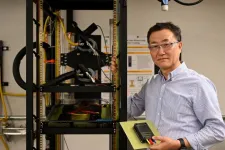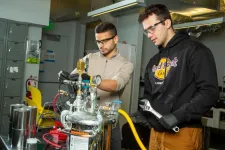(Press-News.org) Professor Morawska, director of THRIVE, from QUT’s School of School of Earth and Atmospheric Sciences said the rapid global spread of Covid-19 had soon made it clear the world was unprepared to respond appropriately.
“In the early days of the pandemic the World Health Organisation and many national health authorities claimed the virus was ‘not in the air’ but rather present in large quantities on surfaces. This led to a misconception about how the virus was transmitted,” Professor Morawska said.
“Public health authorities rejected existing knowledge which led to misguided control measures aimed at cleaning surfaces, instead of ventilation, filtration, face-masking and deactivation of airborne viruses.
“However, for science and building engineering experts there was no doubt from the beginning that the virus was transmitted predominantly through the air and the most important control measure to reduce infection risk was to remove the viruses from the air through ventilation or inactivate them through UVC radiation.”
Based on scientific and advisory activities of the co-authors of the paper, they identified seven lessons of particular importance to indoor air quality (IAQ):
1. The first lesson is to develop means for interdisciplinary knowledge to contribute to public health decision-making.
The experts who advised the WHO at the beginning of the pandemic were mostly public health experts and the value of physical, chemical and engineering expertise was seen as less relevant.
For example, current epidemiological studies of outbreaks commonly do not include the measurement of ventilation rates, which results in incomplete assessment.
2. Ventilation beyond the ‘open window’ solution: modern society cannot rely solely on natural ventilation in building that are not designed to provide sufficient and effective air supply.
Mechanical ventilation must be part of the solution – they offer various air supply techniques such as mixing, displacement and personal ventilation and air disinfection using germicidal ultraviolet and filtration.
3. Building design and ventilation performance: different types of buildings – housing, offices, shopping centres, airports, railway stations, school buildings etc - are becoming increasingly complex, but are mostly planned and built with design and operation constraints.
Sufficient ventilation, which is the basic function to make a building liveable, is often not considered among the key criteria. Building and ventilation design are closely related and equally important in planning and operation.
4. Equivalent ventilation for existing buildings: Buildings such as aged care facilities and schools that are naturally ventilated cannot be easily or cost effectively retrofitted. In such cases equivalent ventilation is needed using the techniques of air filtration and germicidal ultraviolet radiation.
Filtering does not remove water, carbon dioxide and gaseous pollutants from the air but it is “equivalent to ventilation” for particulate matter. Germicidal UV deactivates pathogens in the air so it may be ‘equivalent to ventilation’ in relation to infection control.
5. Ventilation control and risk assessment tools: risk assessment tools have value in estimating the probability of airborne infection but are too complex as a day-to-day control measure in modern buildings. New technologies are being researched, developed or optimized to control the ventilation of buildings.
6. Monitoring ventilation performance: we learned that ventilation performance should be monitored at all the times when buildings are occupied to dynamically to inform ventilation control in response to building occupancy and use.
Numerous CO2 monitors are installed in modern buildings and a proliferation of low-cost CO2 sensors are available for continuous monitoring of ventilation performance in housing and transport cabins, with the preferred method for measuring CO2 being non-dispersive infrared (NDIR).
Modern devices are calibrated against reference methods and their performance can be improved using machine learning tools. The combination with other relevant parameters is possible and recommended.
7. IAQ mandated in public buildings: IAQ must be mandated and controlled like water and food by the relevant authorities. We learned that without regulations, good IAQ cannot be assured by volunteer occupants’ efforts or even building operators if the building was not designed with this as an objective and/or equipped with adequate engineering systems.
The COVID-19 pandemic showed us that not only is ventilation a key control measure to lower the risk of airborne infection transmission of any pathogens, but also that ventilation must be considered as part of the control of IAQ from outdoor generated pollution, beyond infection transmission.”
Ventilation and indoor airborne infection transmission: Lessons learned from the COVID-19 pandemic was published in Science.
END
Seven steps to achieving the right to clean indoor air post-pandemic
2024-07-25
ELSE PRESS RELEASES FROM THIS DATE:
Scientists study how to bring you ‘climate-smart coffee’
2024-07-25
Crave that cup of coffee in the morning? Globally, consumers drink more than 2.2 billion cups daily. Someone grows all that joe: More than 100 million farmers worldwide produce coffee.
Coffee beans consumed across the globe come from two species: Coffea arabica and Coffea canephora, also known as Robusta (or Conilon) coffee. Historically, coffee drinkers prefer Arabica beans for their specific flavor and aroma, said Felipe Ferrao, a University of Florida research assistant scientist in horticultural sciences.
But by 2050, about 80% of Arabica production is predicted to decrease because of climate change. So, Ferrao and colleagues from France (RD2 Vision) and Brazil (Incaper ...
New study shows at-home colon cancer screening test reduces risk of colorectal cancer death, as effective as screening colonoscopy
2024-07-25
COLUMBUS, Ohio – A noninvasive colorectal cancer screening test that can be done at home could reduce the risk of colorectal cancer death by 33%, according to a new study published in JAMA Network Open. This is the first study to evaluate this tool’s effectiveness in specific racial groups.
For this study, researchers at The Ohio State University Comprehensive Cancer Center – Arthur G. James Cancer Hospital and the Richard J. Solove Research Institute (OSUCCC – James), and Kaiser Permanente evaluated data from nearly 11,000 patients who underwent at-home FIT (fecal immunochemical testing) among ...
A cool solution
2024-07-25
Artificial intelligence (AI) is hot right now. Also hot: the data centers that power the technology. And keeping those centers cool requires a tremendous amount of energy.
The problem is only going to grow as high-powered AI-based computers and devices become commonplace. That’s why University of Missouri researcher Chanwoo Park is devising a new type of cooling system that promises to dramatically reduce energy demands.
“Cooling and chip manufacturing go hand-in-hand,” said Park, a professor of mechanical and aerospace engineering in the Mizzou College of Engineering. “Without proper cooling, components overheat and fail. Energy-efficient data centers will be key ...
Electrical currents may make body’s cancer-killing cells even better killers
2024-07-25
Scientists have discovered that electrical currents may make Natural Killer (NK) cells – our very own cancer-killing immune cells – even better killers, which could have significant implications for treating some cancers.
The scientists found that Tumour Treating Fields (TTF) in the laboratory (which mimic exposure of brain tumours to electric currents via a simple hat worn by patients) evoked an even more deadly response from NK cells. They hope their promising findings may open the door to new combined therapies for people living with certain brain tumours, such as glioblastoma.
Glioblastoma is an aggressive, common ...
In Illinois, ‘older adults are at increased risk for suicide’
2024-07-25
Most (83%) suicide deaths were among men
Firearms were the most frequently used weapon (59%)
Among those who died by suicide, 20% had been diagnosed with depression; only 14.1% of them were receiving treatment
CHICAGO --- Nearly 20% of suicides in Illinois between 2020 and 2021 were among people 65 years and older, according to recently released data from Northwestern University Feinberg School of Medicine. The suicides disproportionately affected white men between the ages of 65 and 74 years, with ...
Raindrops grow with turbulence in clouds
2024-07-25
Scientists for decades have attempted to learn more about the complex and mysterious chain of events by which tiny droplets in clouds grow large enough to begin falling toward the ground. Better understanding this process, known as the “rain formation bottleneck,” is fundamental to improving computer model simulations of weather and climate and ultimately generating better forecasts.
Now a research team led by scientists at the U.S. National Science Foundation National Center for Atmospheric Research (NSF NCAR) ...
Penn researchers reveal how a bacterium supports healing of chronic diabetic wounds
2024-07-25
PHILADELPHIA – There are many important reasons for keeping cuts and sores clean, but new research from the Perelman School of Medicine at the University of Pennsylvania shows that a certain bug, Alcaligenes faecalis (A. faecalis), can facilitate healing of hard-to-treat wounds among people with diabetes. While there are many studies done on potentially harmful bacteria in wounds, the researchers discovered that A. faecalis, a bacterium found in many types of chronic wounds, actually boosts healing of diabetic wounds. The researchers found that the beneficial bacterium can promote ...
A recipe for zero-emissions fuel: Soda cans, seawater, and caffeine
2024-07-25
A sustainable source for clean energy may lie in old soda cans and seawater.
MIT engineers have found that when the aluminum in soda cans is exposed in its pure form and mixed with seawater, the solution bubbles up and naturally produces hydrogen — a gas that can be subsequently used to power an engine or fuel cell without generating carbon emissions. What’s more, this simple reaction can be sped up by adding a common stimulant: caffeine.
In a study appearing today in the journal Cell Reports Physical Science, the researchers show they can produce hydrogen gas by dropping pretreated, pebble-sized aluminum pellets into a beaker ...
Study suggests preoperative iron infusions work better than blood transfusions for some anemic patients
2024-07-25
In a rigorous medical records study covering tens of thousands of patients, Johns Hopkins Medicine researchers conclude that some patients with preoperative anemia have better outcomes if they get iron infusions before surgery rather than standard red blood cell transfusions.
The findings, published July 22 in Anesthesia & Analgesia, contribute to mounting evidence that such iron infusions, which boost the production of a person’s own red blood cells, are better than relying on someone else’s blood.
“Anemia ...
UH engineer develops technique that enhances thermal imaging and infrared thermography for police, medical, military use
2024-07-25
A new method to measure the continuous spectrum of light, developed in the lab of University of Houston professor of electrical and computer engineering Jiming Bao, is set to improve thermal imaging and infrared thermography, techniques used to measure and visualize temperature distributions without direct contact with the subject being photographed.
Because they are highly sensitive, thermal cameras and infrared thermometers measure temperature accurately from a distance, making them versatile and valuable tools in many fields from the military to medical diagnostics. They detect infrared radiation, ...



